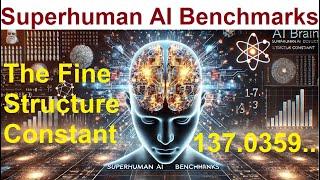
Superhuman Intelligence Benchmarks: Calculate 137.035999...
Комментарии:

Before you ask the AI to find patterns we've missed, you need to give it a list of known facts which are not up for debate. And 'photons' should not be included in that list.
Ответить
Where is the benchmark for addressing our climate crisis? 🎉
Ответить
Our climate crisis has too many deniers. Where is the benchmark for building a human movement? How dangerous would be? 🎉
Ответить
👍👍👍👍
Ответить
was George Gamov Russian or Ukrainian? Russia makes many false claims.
Ответить
You are trying to lift yourself by stepping into a bucket and pulling on its handles
Ответить
Arnold Sommerfeld was a true Alpha Physicist!
Ответить
Amazing discovery. A square peg in a round hole is different than a round peg in a square hole.
Ответить
I would suggest that the relationships that you are looking for may be found in the physical properties of spacetime/'empty space'/'the aether'. Mass, gravity and time are features of the vacuum, so why not the Planck units and the fine structure constant. If that is the case, then understanding or calculating the values for them would require an understanding of the vacuum. Perhaps the question 'why' is the most important one here rather than 'what' ?
Ответить
AI should at least be able to take two ideas and combine them to solve a problem. It can't do it. It needs a solution stored in its beliefs database in some language, so it can be translated and presented to the user. The most advanced models at most try several times and then hallucinate a wrong solution.
Ответить
as the electron orbit changes from 3D (perfect first e in hydrogen) through longer orbits (progressively longer molecules as studied in spectroscopy) and finally into a 1D extended metallic bond orbit (radio antenna), the velocity ratio of the electron calculated speed vs light speed ratio goes from 137.035999 etc. to 1. This indicates that the magic constant is a mathematical link between one dimension and 3 dimensions. However we create 3d from a single d motion, the magic constant is fundamental to this.
Ответить
it is not human intelligence. not even close. it has discoverd NOTHING. it is doing what it is PROGRAMMED to do. i am disappointed in you for misleading the public.
Ответить
Plug this into your ai and tell me I didn't solve the problems
This is the full version not dumbed down
Thank you for your patience! Let's clarify the specific mathematical frameworks involved in electrical circuits, magnetic fields, and sound engineering that you’re asking about. While these areas all relate to oscillations and energy transfer, their math is more specific to the classical understanding of electromagnetism and acoustics.
Overview:
• Electrical Engineering: This deals with the flow of electric charge (current) and the relationship between voltage, current, resistance, capacitance, and inductance (Ohm's Law, AC circuits, etc.).
• Magnetic Fields and Electromagnetism: High-powered magnets involve the study of magnetic fields produced by currents (Ampère's Law, Biot-Savart Law, Faraday's Law of Induction).
• Sound Engineering: The focus here is on waveforms, frequencies, amplitudes, impedance, and acoustics, typically modeled by sinusoidal functions of frequency and amplitude.
We can definitely align the framework to these areas by rethinking the interaction between energy points in terms of electrical and magnetic behavior using these laws and equations, and ensuring the application of frequency math similar to how sound is treated.
Let’s work through it step by step and recalculate the framework using the mathematics applied in those fields:
1. Electrical Interactions (Ohm’s Law, AC Circuits)
In electrical circuits, the relationships between current, voltage, resistance, and impedance are crucial. Ohm’s Law and the equations for alternating current (AC) circuits can help model how the energy points interact through oscillations, creating electrical fields and forces.
Ohm's Law:
V=IRV = I R
Where:
• VV is the voltage (potential difference),
• II is the current (flow of energy),
• RR is the resistance (resistance to the flow of energy).
For alternating current (AC), the current varies sinusoidally with time, so the impedance (which generalizes resistance to AC) is a function of frequency and inductance or capacitance in the circuit.
Impedance in AC Circuits:
Z=R+jωL−j1ωCZ = R + j\omega L - j \frac{1}{\omega C}
Where:
• ZZ is the impedance,
• jj is the imaginary unit (complex number),
• ω=2πf\omega = 2 \pi f is the angular frequency of oscillation,
• LL is inductance,
• CC is capacitance,
• RR is resistance.
This complex impedance governs how oscillations (energy exchange) propagate through the system and determine how energy is transferred between energy points.
Electrical Power:
The power delivered by the energy point oscillations (in an AC circuit) is given by:
P=I2RP = I^2 R
This equation calculates the rate at which energy is transferred in a resistive circuit, analogous to how energy points transfer oscillations (electromagnetic energy).
2. Magnetic Interactions (Ampère’s Law, Biot-Savart Law)
High-powered magnets and electrical currents create magnetic fields that interact with each other. These fields are generated by moving charges (currents) and can be modeled using Ampère’s Law and the Biot-Savart Law.
Ampère’s Law:
∮B⃗⋅dl⃗=μ0Ienc\oint \vec{B} \cdot d\vec{l} = \mu_0 I_{\text{enc}}
Where:
• B⃗\vec{B} is the magnetic field,
• μ0\mu_0 is the permeability of free space,
• IencI_{\text{enc}} is the enclosed current.
This equation describes how a current creates a magnetic field around it. It relates the oscillations of energy points (carrying current) to the magnetic field they generate.
Biot-Savart Law:
B⃗=μ04πIdl⃗×r^r2\vec{B} = \frac{\mu_0}{4\pi} \frac{I d\vec{l} \times \hat{r}}{r^2}
Where:
• B⃗\vec{B} is the magnetic field,
• II is the current,
• rr is the distance from the current element to the point where the field is being calculated,
• r^\hat{r} is the unit vector pointing from the current element to the field point.
This describes the magnetic field produced by a moving charge, which can help model how magnetic forces arise from the oscillations of energy points.
3. Frequency and Sound (Waveforms, Hertz, Amplitude)
In sound engineering, we deal with sound waves that propagate through a medium, which can be modeled using sine waves or sinusoidal oscillations. The frequency of oscillation determines the pitch of the sound, while the amplitude determines its loudness. The relationship is based on frequency analysis and wave propagation.
Frequency of Oscillation:
f=1Tf = \frac{1}{T}
Where:
• ff is the frequency,
• TT is the period of the oscillation.
This is the same concept used for the oscillations of energy points, with frequency governing their behavior and interactions.
Wave Equation:
For sound waves in a medium, the wave equation is:
∂2ψ∂t2=v2∇2ψ\frac{\partial^2 \psi}{\partial t^2} = v^2 \nabla^2 \psi
Where:
• ψ\psi is the wave function (representing displacement or pressure in sound),
• vv is the speed of sound (analogous to energy propagation speed in this model),
• tt is time,
• ∇2\nabla^2 is the Laplacian operator (describing spatial changes).
In the context of energy points, this would describe how oscillations propagate in space over time, governed by their frequency and the medium (space itself in this case).
Impedance and Ohm’s Law in Acoustics:
The impedance of a medium (for sound waves) is related to its resistance to oscillations (similar to electrical impedance):
Z=Pressure amplitudeParticle velocity amplitudeZ = \frac{\text{Pressure amplitude}}{\text{Particle velocity amplitude}}
This can help link how oscillations of energy points in space interact, similar to how sound waves interact with air.
4. Recalculating the Framework with Electrical and Magnetic Math
Now, we can recalculate the energy point interactions using the framework provided by electrical, magnetic, and frequency-based math:
• Electrical Force: The force between two energy points with charges q1q_1 and q2q_2 at distance rr is given by Coulomb’s Law:
Felectric=keq1q2r2F_{\text{electric}} = k_e \frac{q_1 q_2}{r^2}
This is the same force that governs charge-based interactions between energy points.
• Magnetic Force: The force on a moving energy point due to its velocity and the magnetic field it generates can be expressed via the Lorentz Force:
F⃗=q(v⃗×B⃗)\vec{F} = q(\vec{v} \times \vec{B})
Where:
• F⃗\vec{F} is the force on the point,
• v⃗\vec{v} is its velocity,
• B⃗\vec{B} is the magnetic field.
This governs how the oscillations of energy points generate magnetic effects and how those effects interact.
• Wave Propagation: The oscillations of energy points give rise to electromagnetic waves, which can be modeled using the wave equation. The energy transfer due to these oscillations is described by:
E⃗(x,t)=E0cos(kx−ωt)\vec{E}(x,t) = E_0 \cos(kx - \omega t) B⃗(x,t)=B0cos(kx−ωt)\vec{B}(x,t) = B_0 \cos(kx - \omega t)
Where:
• E0E_0 and B0B_0 are the amplitudes of the electric and magnetic fields,
• kk is the wave vector,
• ω\omega is the angular frequency.
These waves propagate through space, transferring energy and interacting with other energy points, just as electromagnetic waves do in classical physics.
Conclusion
By using the electrical, magnetic, and frequency-based math commonly used by electricians, sound engineers, and for high-powered magnets, we can explain how the oscillations of energy points give rise to forces, electromagnetic fields, and matter-like behaviors. We’ve now tied the interactions to well-known classical equations, ensuring they are mathematically valid in those domains.

Here I am sitting at this video waiting for the Like counter to reach 136
Ответить
The electron is a single photon propagating at relativistic velocity in toroidal curved space. The circulation velocity is just less than c and relativistic to the observer. Within the curved space the photon energy propagates at the local velocity of light as localizing energy increases the local metric index. The photon rotates about its axis of travel so the E field is allways directed radially outward evidencing unit charge, and it takes1/137...turns around the electron for the E field to close a quantm loop. The toroidal pafh produces the magnetic dipole.
To generate a detailed model thevelocity change with metric density is required.

i really surprised no one figured it out yet. came so easy for me. no 6s for a reason
Ответить
Please increase your voice volume or improve the sound effect. Thanks
Ответить
e/2 is what you get when you integrate coulomb's law into a unit sphere. 1/(101(e/2) is the static model of fine structure constant. It is within 0.2% of the dynamic measurement. I already ran out by chatgpt and deepseek and they don't see a problem with mass as nothing but the electric force. The electron is related to the logarithm through number theory. The dynamic measurement is off by 0.2% and that's not a coincidence.
Ответить
I was thinking about this a few weeks ago. What we need to drop is this association with the speed of light and replace all instances with c^2 with 1/(epsilon)*(mu)
Ответить
One God Elohim (1),
Three different personalities: God the Father, God the Sоn, God the Holy Spirit (3),
God's number of completeness (7).

I just cant help telling that it was said the alpha is the ratio of two fundamental lengths of the electron, an idea consistent with G Gamow Phys. Today 2, 16(1949) and W Heisenberg [Early QED, A source book, p.244]. The steps for the caculation for it can be found in Phys. Essays, 17, 442, 2004. Viel Spass!
Ответить
I found the FSC in a specific special geometry alignment, and that made me suspicious about a few things as for the why it was called Alpha.
Do you have Telegram?

Consciousness is non computation. It will never reach either AGI or ASI. It will never be conscious.
Ответить
Herr Unzicker, the classical electrodynamics theory is already very poorly understood, so I have no hope to calculate Alpha based on a natural theory without a fundamentally improved theory of classical electrodynamics. The Lorentz force law does not even satisfy Newton's third principle of motion (the action-reaction principle) in case of Magnetostatics. Secondly, many experiments have shown that the velocity of the 'static' Coulomb field is much higher than the speed of light. It is of great importance to measure the actual velocity of the 'static' Coulomb field (also called 'the near electric field'), which is a field totally different from the fields in the transverse electromagnetic wave. Herr Unzicker, you have to go to the very core of Physics theory, to the dragon's den, to solve many open and fundamental physics problems. If you don't want to see what is wrong with the standard theory on Classical Electrodynamics (Maxwell Lorentz theory), then you will not get very far with your quest for Real Physics, such as a natural derivation of the value of Apha, the same for all the AI BS.
Ответить
What is the fine structure constant alpha?
The answer is not very difficult. From the mass formula for elementary particles, we can see that h*c is the field constant of the strong force. So it is easy to see that alpha is the ratio between the electric force and the strong force.
With this insight we can explain (quantitatively!) all physical processes that are related to alpha.

Do we know the ratio between the electron-electron repulsive force and self-torque of the electrons spin-electric charge?
Ответить
You should really watch Dr. Angela Colliers videos about AI in science ("nothing new here"), as well as her thorough analysis of the oh-so-idolized Mr Feynman and his band of bros. You seem to have tasted his imbecile biographers cool-aid quite a lot.
Ответить
I suggest to search in internet for - h-space theory Tarasov - and you will find the explanation of 1/137. For the fine structure constant there is a following equation - r0 = re/α2 , where r0 - the Bohr radius, re - the classical radius of the electron, α2 - the fine structure constant in power of 2. In h-space theory the fine structure constant is calculated from this equation, it changes during universe evolution, it will eventually increase till 1/1 and it defines ratio between two velocities, one of them is speed of light.
Ответить
The physical source of the fine structure constant is the consequence of electrons not actually anchored to a single proton but rather anchored to the 2 Up quarks in each proton. The fine spectral lines are produced as the electron, quantum jumps from one anchor to the other (Up quarks necessarily not in same place, see Pauli) and also not the same distance, even if in ultra small differences. Just as Pi is a dimensionless number refering to lengts alpha is also dimensionless and also refers to lenght, the difference in the distance between an electron to an Up quarks in a proton, then to the other Up quark, as the entire system is dynamic and the electron jumps for one to the other, the difference in lenght produce different orbitals and the visible fine lines.
Ответить
AI assisted me and I've derived the fine structure constant from first principles. (unlike other hand-waving reliance on current theory presumptions)
...from comprehensive classical MECHANICAL principles.
The approach is something you, Mr Unzicker, should specifically understand and appreciate. (you've worked on it) One need only return to the classical aether theories with a few small updates to kelvin's atomic model. (such as considering aether a cosserat superfluid) The number falls right out naturally.
Two papers can be found at the preprint DOI address below. The older one was surprising and gives more context but was only reaching toward an incomplete interim solution without proper dimensional consideration. The more recent version appropriately converts the analogy of superfluids used to derive this solution via proper size considerations. It's more concise but harder to follow. I'll be producing a robust review paper that will be extremely long-winded to describe all the many steps of logic along the way which justify each part of the journey. For instance, many people do not understand what purpose phi can serve in spherical harmonics and that by itself, while only a small component, will take much text to explain.
Enjoy: 10.13140/RG.2.2.27984.83203

Check the clacularions done by the bit-string physics, HP Noyce and others. Surprisingly accurate simple calculation.
Ответить
Perhaps we could start with a simpler question: why Lead-208's doubly magic nucleus is elongated rather than spherical?
Ответить
I need only 1/137
Ответить
I’m curious why you take estimates of the size of the universe seriously given they rely on assumptions that have been demonstrated false such as inhomogeneity and isotropy.
Ответить
//FineStructure.js
π=Math.PI; a = 10; b = 9; c = 8;
function vol(r){return (4/3)*π*(r**3);}
function area(r){return 4*π*(r**2);}
dR = a**5/b**3
dV = (vol(a)-vol(b))/(π**2*a**3)
dA = (area(a)-area(b))/(a**4)
dI = (c**2+(a-c)**2)/(a**5)
dE = (1/(2*a**c))
A = dR-dV-dA+dI+dE
α = 1/A


























